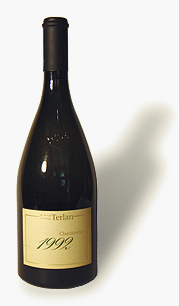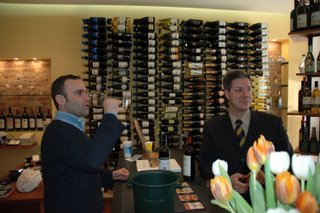Sighart Donabaum Riesling 2004
 Last night I was enjoying my day off and decided to open the magnum I had in the fridge since Thanks Giving.
Last night I was enjoying my day off and decided to open the magnum I had in the fridge since Thanks Giving.
Austria is still paying from the 1985 scandal of Di ethylene Glycol . During that period some Austrian vintners used that chemical to higher the sugar level in order to create sweet wines from dry ones. It is definitely more costly, and accordingly more expensive to buy, to produce a dessert wine than a dry one and simply adding sugars is too easy to detect and therefore to be caught by the authority. The scandal create some sort of "vintners cleaning", were just the wineries that carried a good reputation survived the conjuncture supplying the domestic market. The good part is that now you can go in Austria and still have available vintages dating back to 80's; I had the fortune to drink several bottles in different occasion of Peter Schandl Pinot BlancRuster 1989. The wine has travelled just once from the winery to here and I think that's the reason why every time I had it was in spectacular condition with no bottle variation what so ever. For the 17 years those bottles sat under the barrels of Schandl's cellar in humid conditions, as you can see from the label (sorry for the quality of the picture, I took it with my phone), covered with  mildew at constant temperature without being moved. In my "wish trip" list Austria is in fact at the top, hopefully I can make it by next year and bring back some good bottles.
mildew at constant temperature without being moved. In my "wish trip" list Austria is in fact at the top, hopefully I can make it by next year and bring back some good bottles.
Now going back to the Donabaum, we start to enjoy the wine as aperitif without food. Just opened the Riesling was already showing citrus flavors of Grapefruit, typical in Austrian whites, marked acidity and bouquet of honeydew melon.
It was still a bit closed and probably a bit too cold as well, but still the scent went directly into my brain triggering the calming vision of green cold valleys were the grapes absorb every second of light before going to sleep during the cold nights. After an hour or so we had some nice aged steak that Wolfgang's kindly delivered to us. We still had enough wine in the bottle for the dinner so I just decided to try Riesling with rare steak, the result was quite nice. At that point it had developed; notes of fresh apricots and crispy minerality cleaned my palate getting my mouth ready for the next bite of meat, it also worked really well with the creamed spinach and, believe it or not, even with the onion rings!!! I think this is the first time that I had a white wine with a porterhouse, now I still think that a nice red with strong tannins would have worked better with it but the outcome was surprising. The bottle was big and the 3 of us were still tested by the holiday weekend so we had some left in the bottle. Going to the next task I've tried to see if it would work also with some dessert.
I had in the fridge some left over Pastiera Napoletana, a ricotta with candied orange and cider based cake, a Neapolitan specialty, and had some; the flavors of the candied fruit was amplified by the wine creating a perfect match with the citrus notes of the Riesling leaving a nice and clean after taste. Overall the only defects I could perceive from the wine were mostly connected to the young age of it (2004 is the current vintage and when just opened it was lacking of depth and complexity which had developed some time after that), the biggest plus was the versatility of it the way it have connected with several different kind of food, we also had some crab meat, and without food.
I'll be curious to know if anybody else had some similar experiences.
Buona Bevuta a Tutti




















